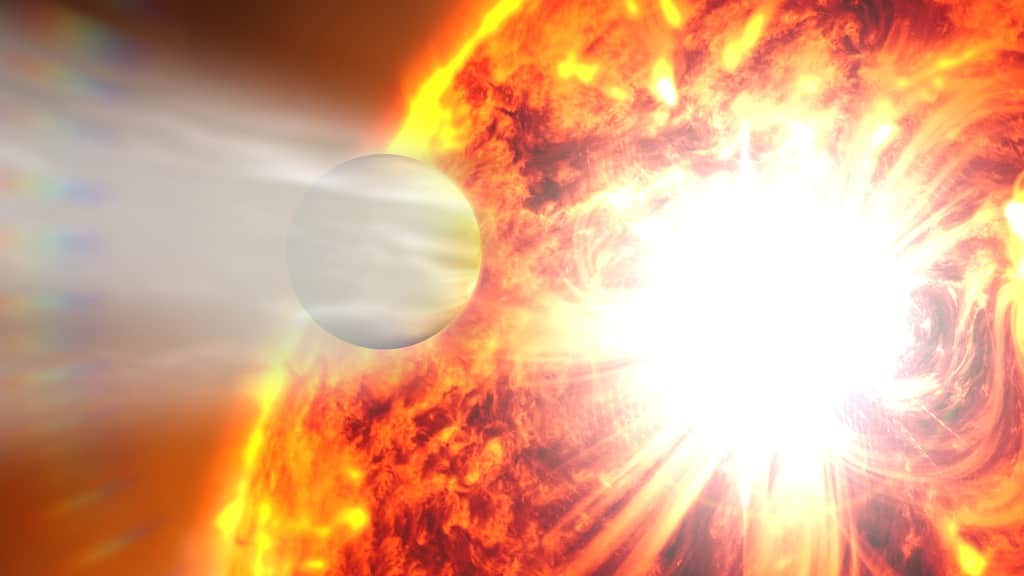
One of the most intriguing phenomena astronomers have been studying for years is that stars consume planets as they run out of fuel. As a star approaches the end of its life, it expands to a million times its original size, swallowing any matter — including planets — that comes in its path.
Now, astronomers recently observed this phenomenon for the first time. The study on the phenomenon was published in Nature by researchers from MIT, Harvard University, Caltech and other institutions.
Planetary lunch in progress
In the constellation Aquila, a star located about 12,000 light-years away from Earth became more than 100 times brighter in just 10 days, before rapidly fading away. Scientists believe this outburst was due to the star engulfing a nearby planet. This would be the first time a star consuming a planet has been directly observed.
“For decades, we’ve been able to see the before and after,” says lead author Kishalay De, a postdoc in MIT’s Kavli Institute for Astrophysics and Space Research, who witnessed the event.
“Before, when the planets are still orbiting very close to their star, and after, when a planet has already been engulfed, and the star is giant. What we were missing was catching the star in the act, where you have a planet undergoing this fate in real-time. That’s what makes this discovery really exciting.”
Researchers believe the planet that perished was likely a hot, Jupiter-sized planet pulled into the star’s atmosphere and then its core.
“We were seeing the end-stage of the swallowing,” De said. “One night, I noticed a star that brightened by a factor of 100 over the course of a week, out of nowhere. It was unlike any stellar outburst I had seen in my life.”
The team discovered the event in May 2020, but it took another year for the astronomers to piece together what the outburst could be. First, they observed the star with the Zwicky Transient Facility (ZTF), which scans the sky for stars that rapidly change in brightness, looking for signs of eruptions in stellar binaries.
De then looked to observations of the same star taken by the Keck Observatory in Hawaii. The Keck telescopes take spectroscopic measurements of starlight, which scientists can use to discern a star’s chemical composition.
But what De found further puzzled him. While most binaries give off stellar material such as hydrogen and helium, the new source gave off neither. Instead, De saw signs of “peculiar molecules” that can only exist at very cold temperatures.
“These molecules are only seen in stars that are very cold,” De said. “And when a star brightens, it usually becomes hotter. So, low temperatures and brightening stars do not go together.”
About a year after the initial discovery, De and his colleagues analyzed observations of the same star, this time taken with an infrared camera at the Palomar Observatory. Astronomers can see signals of colder material within the infrared band, in contrast to the white-hot, optical emissions that arise from binaries and other extreme stellar events.
“That infrared data made me fall off my chair,” De says. “The source was insanely bright in the near-infrared.”
It appeared that the star continued to throw out colder energy over the next year after its initial hot flash. That frigid material was likely gas from the star that shot into space and condensed into dust, cold enough to be detected at infrared wavelengths. This data suggested that the star could be merging with another star rather than brightening because of a supernova explosion.
When the team further analyzed the data and paired it with measurements taken by NASA’s infrared space telescope, NEOWISE, they came to a much more exciting realization. From the compiled data, they estimated the total amount of energy released by the star since its initial outburst and found it to be surprisingly small. It was about 1/1,000 the magnitude of any stellar merger observed in the past.
“That means that whatever merged with the star has to be 1,000 times smaller than any other star we’ve seen,” De says. “And it’s a happy coincidence that the mass of Jupiter is about 1/1,000 the mass of the sun. That’s when we realized: This was a planet, crashing into its star.”
The same fate is expected for Earth in about five billion years when the sun begins to burn out and consume the inner planets.
“If some other civilization was observing us from 10,000 light-years away while the sun was engulfing the Earth, they would see the sun suddenly brighten as it ejects some material, then form dust around it, before settling back to what it was,” De said.









